|
Author
|
Topic: ISRO (India) RLV-TD uncrewed winged spacecraft
|
JBoe
Member Posts: 960
From: Churchton, MD
Registered: Oct 2012
|
 posted 05-20-2015 07:28 PM
posted 05-20-2015 07:28 PM
   
I came across an interesting article from the Indian Express discussing their reusable launch vehicle. ISRO has tentatively slated the prototype's test flight from the first launchpad of Sriharikota spaceport for July this year, but the date would be finalised depending on the completion of construction....for the test mission, the unmanned space plane part would glide into the Bay of Bengal a la the recent crew module successfully tested aboard the Geosynchronous Satellite Launch Vehicle Mk-III (GSLV Mk-III) experimental flight last year. The RLV-TD is strikingly similar in design to the X-37B as depicted in the article. Chairman of the Indian Space Research Organisation (ISRO), A S Kiran Kumar, states the space plane as "almost ready" and the 1.5 ton vehicle could fly to 70km. |
Robert Pearlman
Editor Posts: 42988
From: Houston, TX
Registered: Nov 1999
|
 posted 05-20-2015 07:36 PM
posted 05-20-2015 07:36 PM
   
Indian Space Research Organization (ISRO) release RLV-TD: Reusable Launch Vehicle Technology Demonstration ProgramThe cost of access to space is the major deterrent in space exploration and space utilization. A reusable launch vehicle is the unanimous solution to achieve low cost, reliable and on-demand space access. 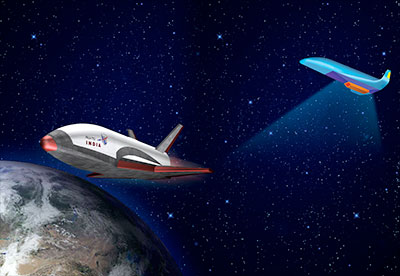 Reusable Launch Vehicle-Technology Demonstration Program or RLV-TD is a series of technology demonstration missions that have been considered as a first step towards realizing a Two Stage To Orbit (TSTO) fully re-usable vehicle. A Winged Reusable Launch Vehicle technology Demonstrator (RLV-TD) has been configured to act as a flying test bed to evaluate various technologies, namely, hypersonic flight, autonomous landing, powered cruise flight and hypersonic flight using air-breathing propulsion. These technologies will be developed in phases through a series of experimental flights. The first in the series of experimental flights is the hypersonic flight experiment (HEX) followed by the landing experiment (LEX), return flight experiment (REX) and scramjet propulsion experiment (SPEX). Reusable Launch Vehicle Technology Demonstrator Hypersonic Experiment (RLV-TD HEX1) wherein the hypersonic aero-thermo dynamic characterization of winged re-entry body along with autonomous mission management to land at a specified location and characterization of hot structures are planned to be demonstrated. |
Robert Pearlman
Editor Posts: 42988
From: Houston, TX
Registered: Nov 1999
|
 posted 12-29-2015 02:20 PM
posted 12-29-2015 02:20 PM
   
Technical snags have forced ISRO to put off the first test of a scaled-down prototype of its reusable winged spacecraft, The New Indian Express reports. Sources said on Sunday [Dec. 27] that the Reusable Launch Vehicle-Technology Demonstrator (RLV-TD), under development at the Vikram Sarabhai Space Centre (VSSC) here at Thumba, developed a minor leak during a test, forcing the ISRO to postpone the mission. The ambitious RLV-TD, the first small step to building a 'space shuttle' which can return to earth after accomplishing space missions, is likely to be delayed up to April 2016. ISRO had originally planned a mid-2015 launch for the RLV-TD. It had later been postponed to January 2016.VSSC Director Dr K Sivan said that some of the components had to be re-assembled. "If things go as planned, we can launch the mission in the first week of February. Otherwise, the test will be conducted in the first week of April," he said. |
Robert Pearlman
Editor Posts: 42988
From: Houston, TX
Registered: Nov 1999
|
 posted 05-23-2016 08:05 AM
posted 05-23-2016 08:05 AM
   
Indian Space Research Organization (ISRO) release India's Reusable Launch Vehicle-Technology Demonstrator (RLV-TD), Successfully Flight TestedToday, May 23, ISRO successfully flight tested India's first winged body aerospace vehicle operating in hypersonic flight regime. In this experimental mission, the HS9 solid rocket booster carrying RLV-TD lifted off from the First Launch Pad at Satish Dhawan Space Centre, Sriharikota at 07:00hr IST. After a successful flight of 91.1 second, HS9 burn out occurred, following which both HS9 and RLV-TD mounted on its top coasted to a height of about 56 km [35 mi]. At that height, RLV-TD separated from HS9 booster and further ascended to a height of about 65 km (40 mi). 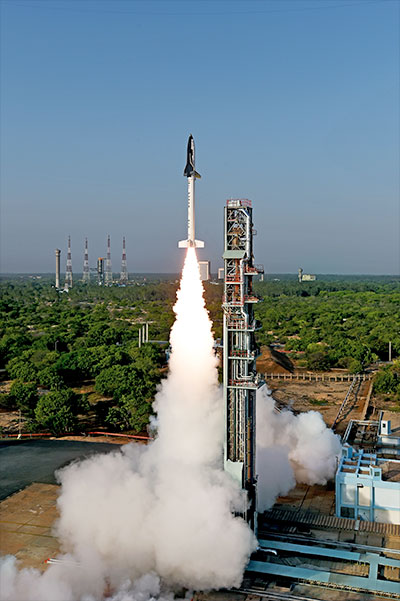 From that peak altitude of 65 km, RLV-TD began its descent followed by atmospheric re-entry at around Mach 5 (five times the speed of sound). The vehicle's Navigation, Guidance and Control system accurately steered the vehicle during this phase for safe descent. After successfully surviving a high temperatures of re-entry with the help of its Thermal Protection System (TPS), RLV-TD successfully glided down to the defined landing spot over Bay of Bengal, at a distance of about 450 km from Sriharikota, thereby fulfilling its mission objectives. The vehicle was successfully tracked during its flight from ground stations at Sriharikota and a shipborne terminal. 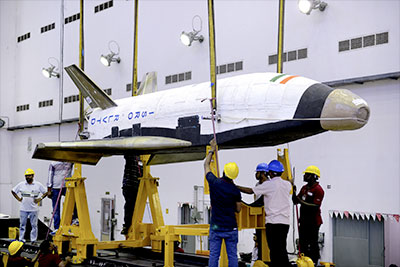 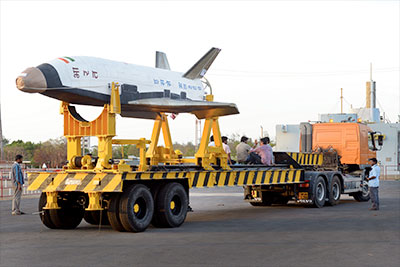
Total flight duration from launch to landing of this mission of the delta winged RLV-TD, lasted for about 770 seconds. In this flight, critical technologies such as autonomous navigation, guidance and control, reusable thermal protection system and re-entry mission management have been successfully validated. ISRO acknowledge the support of Indian coast guard and National Institute of Ocean technology (NIOT) for the mid sea wind measurement and shipborne telemetry respectively in this mission. 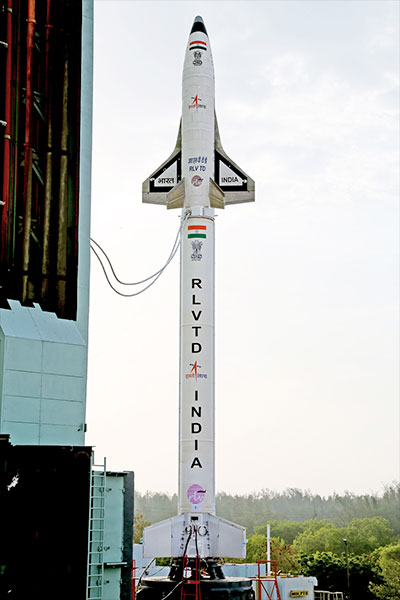 |
cspg
Member Posts: 6210
From: Geneva, Switzerland
Registered: May 2006
|
 posted 05-23-2016 09:06 AM
posted 05-23-2016 09:06 AM
   
Funny to see that India is following the US DoD... |
Robert Pearlman
Editor Posts: 42988
From: Houston, TX
Registered: Nov 1999
|
 posted 05-23-2016 09:18 AM
posted 05-23-2016 09:18 AM
   
Other than the X-37B (assuming that is what you're referring to) and RLV-TD both having wings, the two exist for different reasons. The X-37B is a platform for testing orbital capabilities. The RLV-TD is a demo towards developing a reusable, two-stage launch vehicle. In that sense, the RLV-TD has more in common with SNC's Dream Chaser than it does the X-37B. |
Cozmosis22
Member Posts: 968
From: Texas * Earth
Registered: Apr 2011
|
 posted 05-23-2016 12:40 PM
posted 05-23-2016 12:40 PM
  
Bravo, India!One thing is a bit unclear. Did this test article parachute to a water landing in the Bay of Bengal? |
SpaceAholic
Member Posts: 4437
From: Sierra Vista, Arizona
Registered: Nov 1999
|
 posted 05-23-2016 04:15 PM
posted 05-23-2016 04:15 PM
   
quote:
Originally posted by Robert Pearlman:
The RLV-TD is a demo towards developing a reusable, two-stage launch vehicle.
Weaponized hypersonic glide vehicle (HGV) platforms are developed using the same approach. |
Robert Pearlman
Editor Posts: 42988
From: Houston, TX
Registered: Nov 1999
|
 posted 05-23-2016 04:29 PM
posted 05-23-2016 04:29 PM
   
quote:
Originally posted by Cozmosis22:
Did this test article parachute to a water landing in the Bay of Bengal?
It glided to a virtual runway and then splashed down, no parachutes involved. |
JBoe
Member Posts: 960
From: Churchton, MD
Registered: Oct 2012
|
 posted 05-23-2016 05:50 PM
posted 05-23-2016 05:50 PM
   
Since the RLV-TD splashed down, what Indian naval and/or Coast Guard vessel and aircraft recovered it? Although, since there was no parachutes it probably was more of a salvage operation. I'd be interested in any photography from assets in the Bay of Bengal. |
Robert Pearlman
Editor Posts: 42988
From: Houston, TX
Registered: Nov 1999
|
 posted 05-23-2016 06:10 PM
posted 05-23-2016 06:10 PM
   
No details yet on recovery, but the AFP cited a scientist involved in the project saying the vehicle was known to be intact and floating. ("The landing was soft and the vehicle did not break.") |
















